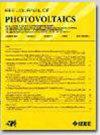Experimental Validation of a Module Cell Cracking Model
IF 2.6
3区 工程技术
Q3 ENERGY & FUELS
引用次数: 0
Abstract
The What's Cracking app can predict how changes in crystalline silicon photovoltaic (PV) module materials, design, and mounting affect its susceptibility for cell fracture under uniform loading. This work has experimentally validated the app. A set of commercial crystalline silicon PV modules was obtained for this study. The modules were uniformly loaded at three different mounting points, and their subsequent cell fractures were recorded. A large sample size allowed for the development of an experimental statistical model for cell fracture. The comparison of the experiment to predictions from the app is in excellent agreement. Both experimental and modeling results also elucidate how moving the module mounting points toward the center of the module increases the probability of cell fracture.模块单元开裂模型的实验验证
What's Cracking应用程序可以预测晶体硅光伏(PV)组件材料、设计和安装的变化如何影响其在均匀载荷下的电池断裂易感性。这项工作已经通过实验验证了该应用程序。本研究获得了一套商用晶体硅光伏组件。在三个不同的安装点均匀加载模块,并记录其随后的细胞断裂。大样本量允许开发细胞断裂的实验统计模型。实验结果与应用程序的预测结果非常吻合。实验和建模结果还阐明了如何将模块安装点移动到模块的中心增加细胞断裂的可能性。
本文章由计算机程序翻译,如有差异,请以英文原文为准。
求助全文
约1分钟内获得全文
求助全文
来源期刊

IEEE Journal of Photovoltaics
ENERGY & FUELS-MATERIALS SCIENCE, MULTIDISCIPLINARY
CiteScore
7.00
自引率
10.00%
发文量
206
期刊介绍:
The IEEE Journal of Photovoltaics is a peer-reviewed, archival publication reporting original and significant research results that advance the field of photovoltaics (PV). The PV field is diverse in its science base ranging from semiconductor and PV device physics to optics and the materials sciences. The journal publishes articles that connect this science base to PV science and technology. The intent is to publish original research results that are of primary interest to the photovoltaic specialist. The scope of the IEEE J. Photovoltaics incorporates: fundamentals and new concepts of PV conversion, including those based on nanostructured materials, low-dimensional physics, multiple charge generation, up/down converters, thermophotovoltaics, hot-carrier effects, plasmonics, metamorphic materials, luminescent concentrators, and rectennas; Si-based PV, including new cell designs, crystalline and non-crystalline Si, passivation, characterization and Si crystal growth; polycrystalline, amorphous and crystalline thin-film solar cell materials, including PV structures and solar cells based on II-VI, chalcopyrite, Si and other thin film absorbers; III-V PV materials, heterostructures, multijunction devices and concentrator PV; optics for light trapping, reflection control and concentration; organic PV including polymer, hybrid and dye sensitized solar cells; space PV including cell materials and PV devices, defects and reliability, environmental effects and protective materials; PV modeling and characterization methods; and other aspects of PV, including modules, power conditioning, inverters, balance-of-systems components, monitoring, analyses and simulations, and supporting PV module standards and measurements. Tutorial and review papers on these subjects are also published and occasionally special issues are published to treat particular areas in more depth and breadth.
 求助内容:
求助内容: 应助结果提醒方式:
应助结果提醒方式:


